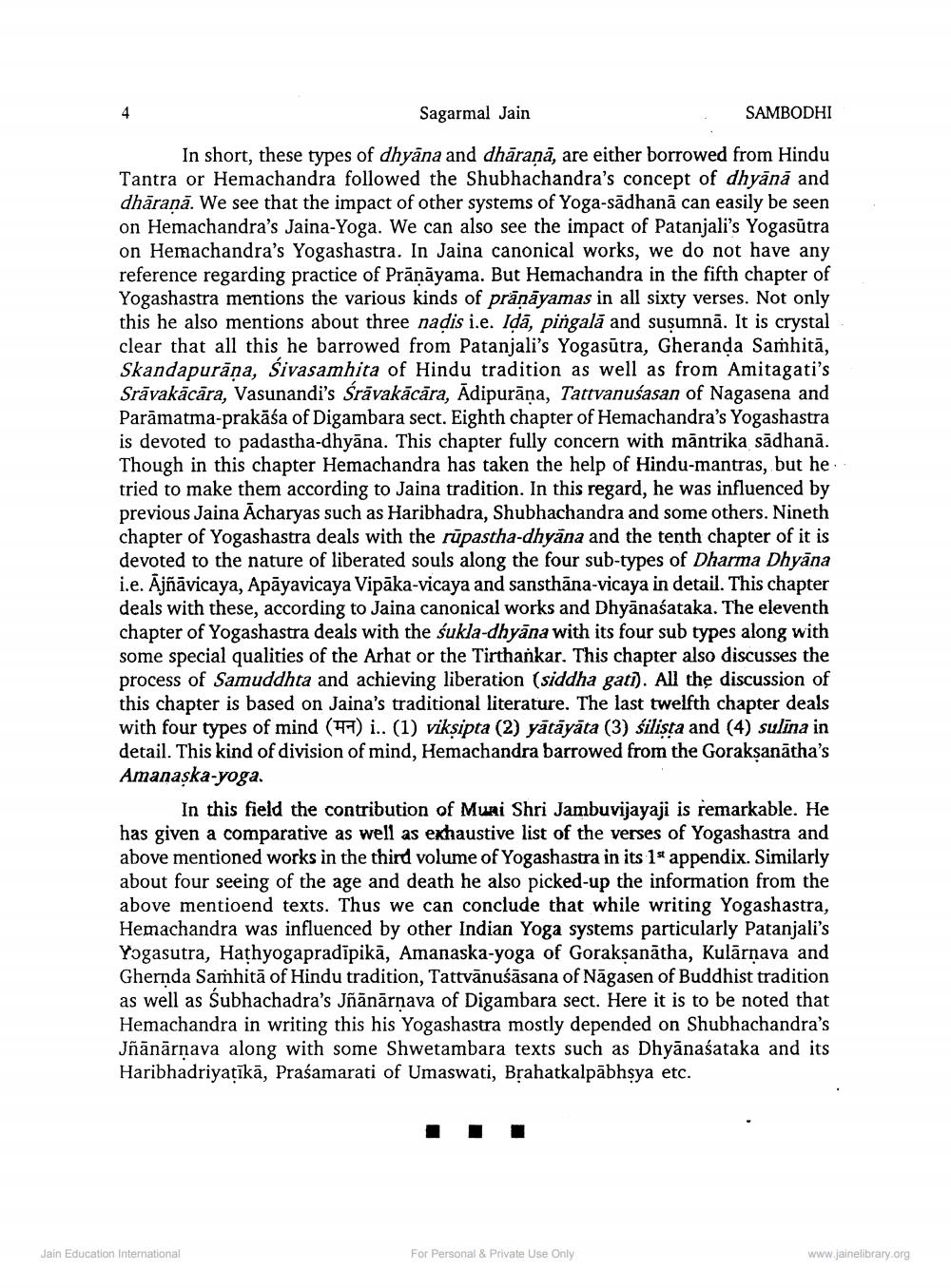________________
Sagarmal Jain
SAMBODHI
In short, these types of dhyāna and dhāranā, are either borrowed from Hindu Tantra or Hemachandra followed the Shubhachandra's concept of dhyānā and dhārana. We see that the impact of other systems of Yoga-sādhanā can easily be seen on Hemachandra's Jaina-Yoga. We can also see the impact of Patanjali's Yogasūtra on Hemachandra's Yogashastra. In Jaina canonical works, we do not have any reference regarding practice of Prāņāyama. But Hemachandra in the fifth chapter of Yogashastra mentions the various kinds of prānāyamas in all sixty verses. Not only this he also mentions about three nadis i.e. Ida, pingalā and suşumnā. It is crystal clear that all this he barrowed from Patanjali's Yogasūtra, Gheranda Samhitā, Skandapurāna, Sivasamhita of Hindu tradition as well as from Amitagati's Srāvakācāra, Vasunandi's Śrāvakācāra, Adipurāna, Tattvanuśasan of Nagasena and Parāmatma-prakāśa of Digambara sect. Eighth chapter of Hemachandra's Yogashastra is devoted to padastha-dhyāna. This chapter fully concern with mantrika sādhanā. Though in this chapter Hemachandra has taken the help of Hindu-mantras, but he tried to make them according to Jaina tradition. In this regard, he was influenced by previous Jaina Acharyas such as Haribhadra, Shubhachandra and some others. Nineth chapter of Yogashastra deals with the rūpastha-dhyāna and the tenth chapter of it is devoted to the nature of liberated souls along the four sub-types of Dharma Dhyāna i.e. Ājñāvicaya, Apāyavicaya Vipāka-vicaya and sansthāna-vicaya in detail. This chapter deals with these, according to Jaina canonical works and Dhyānaśataka. The eleventh chapter of Yogashastra deals with the sukla-dhyāna with its four sub types along with some special qualities of the Arhat or the Tirthankar. This chapter also discusses the process of Samuddhta and achieving liberation (siddha gati). All the discussion of this chapter is based on Jaina's traditional literature. The last twelfth chapter deals with four types of mind (971i.. (1) viksipta (2) yātāyāta (3) śilista and (4) sulīna in detail. This kind of division of mind, Hemachandra barrowed from the Goraksanātha's Amanaska-yoga.
In this field the contribution of Muni Shri Jambuvijayaji is remarkable. He has given a comparative as well as exhaustive list of the verses of Yogashastra and above mentioned works in the third volume of Yogashastra in its 1s appendix. Similarly about four seeing of the age and death he also picked-up the information from the above mentioend texts. Thus we can conclude that while writing Yogashastra, Hemachandra was influenced by other Indian Yoga systems particularly Patanjali's Yogasutra, Hathyogapradīpikā, Amanaska-yoga of Goraksanātha, Kulārnava and Ghernda Samhitā of Hindu tradition, Tattvānuśāsana of Nāgasen of Buddhist tradition as well as Subhachadra's Jñānārnava of Digambara sect. Here it is to be noted that Hemachandra in writing this his Yogashastra mostly depended on Shubhachandra's jñānārnava along with some Shwetambara texts such as Dhyānaśataka and its Haribhadriyatīkā, Praśamarati of Umaswati, Brahatkalpābhsya etc.
Jain Education International
For Personal & Private Use Only
www.jainelibrary.org




